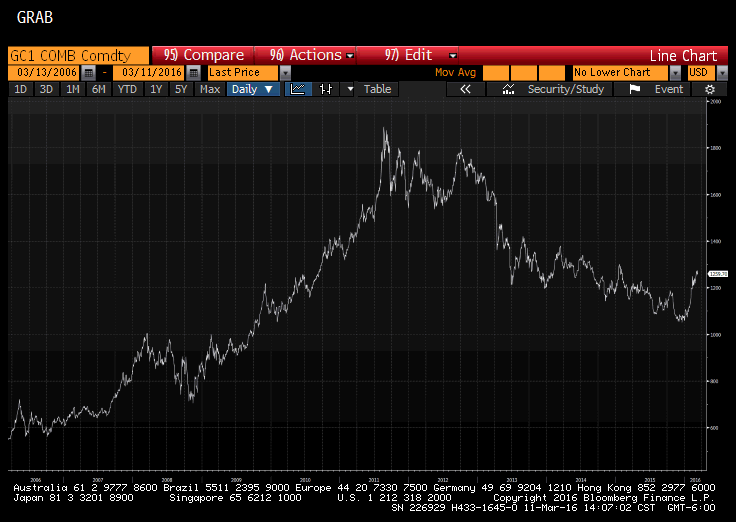Gold has been on a tear lately. It is exciting for all those “investors” (I use that term loosely) who perpetually think the investment world is ending to see the price of gold cease its relentless descent.
Gold has frustrated doomsday investors. After peaking in 2010 at almost $1,900 an ounce, its price plummeted more than 40% over the next five years, hitting $1,050 in late 2015. Since then, gold has rallied over 20% to just under $1,300 (see 10-year graph below).

Don’t get excited. We don’t see any fundamental reason for gold to head back to $1,800+ any time soon.
There are two reasons to own precious metals:
1. Inflation hedge.
The last time we had double-digit inflation (the late 1970s into the 1980s), gold was the best investment for a decade. Hard assets are good investments during periods of high inflation. Today? Countries all over the world are trying to create inflation. They can’t do it. Several central banks have NEGATIVE interest rates today trying to create inflation of just 2%. And so far, it isn’t working. So buying gold as an inflation hedge has no merit.
2. Hedge against economic collapse/recession/depression/you name it disaster.
We don’t see any merit in this either. Although it is nothing to jump up and down about, the U.S. economy continues to grow slowly. There were 242,000 new jobs created in February, and first-time jobless claims are historically low.
Gold has no earnings and pays no dividends. If you are going to get a positive return from owning gold, it is imperative you purchase gold at the right time and sell it at the right time.
Looking at the 10-year graph of gold above, you can see there were several times after the peak of almost $1,900 where gold bounced, only to turn down and head lower. It wouldn’t surprise us if gold does that again.
Donald Trump has changed the landscape of American politics. The series of debates that determine the best nominee to run for president has been temporarily (if not permanently) altered. The ideas that you should wait your turn to speak and that your answers should fit into a pre-determined amount of time was eliminated as Donald said whatever he wanted to say whenever he wanted to say it. Decorum, to the extent there ever was any, was abolished.
The Republican National Convention will be held in Cleveland, Ohio in mid-July. Unless something dramatic happens, Donald will likely be selected as the Republican candidate for president of the United States. I didn’t see THAT ONE coming a year ago!
The Democratic National Convention will be held a week later in Philadelphia. Although Bernie Sanders has waged a campaign surprisingly more challenging than I would have thought; Hillary Clinton will almost surely be selected as the Democratic nominee.
It never occurred to me that anyone would attempt challenging Hillary for the Democratic nomination. And I assumed that if anyone did, he or she would quickly be discouraged and quit… like Christie, Carson, Fiorina, Bush, etc.
And it definitely didn’t occur to me that the candidate mounting a successful challenge would be one spouting a socialistic agenda. My take on this is that Hillary is not running a very good campaign and that our country has left a lot of unhappy low-wage earners behind… primarily young people.
When socialism starts to sound good to the majority, something has gone seriously wrong. Throughout history, it’s been proven in countless countries that socialism on a grand scale does not work. As my cab driver in San Francisco said with a very thick Russian accent, “Socialism is when everyone shares nothing because everyone HAS NOTHING.”
I write all this because I feel presidents get way too much credit and way too much blame for how the economy performs. So when people want my opinion on Trump or Clinton winning the White House, I tell them that we are not changing our investment strategies based upon who becomes president. Unless of course that person is Bernie Sanders. If this becomes a realistic possibility, we would have to reassess our investment strategy and our allocation to the stock market.
With a Republican Congress and a socialistic president, our country would experience political gridlock like never before.
The U.S. stock market has been on a rather wild ride for the first two months of 2016. Through February 29th, the S&P 500 has declined just over 5%. But that is after falling 10.4% in the first month and a half and rallying back the last two weeks of February.
Since then, the volatility has declined dramatically, and stocks have been trending upward through the first half of March.
The panic that spread throughout high yield bonds last year has subsided and high yield bonds are realizing significant gains simply because they ran out of sellers. Everyone who wanted out of high yield bonds got out. In the absence of sellers, it doesn’t take very many buyers to make the price go up.
At Boyer & Corporon Wealth Management, we feel the stock market is fairly valued and remains partially hedged.
This information is provided for general information purposes only and should not be construed as investment, tax, or legal advice. Past performance of any market results is no assurance of future performance. The information contained herein has been obtained from sources deemed reliable but is not guaranteed.
